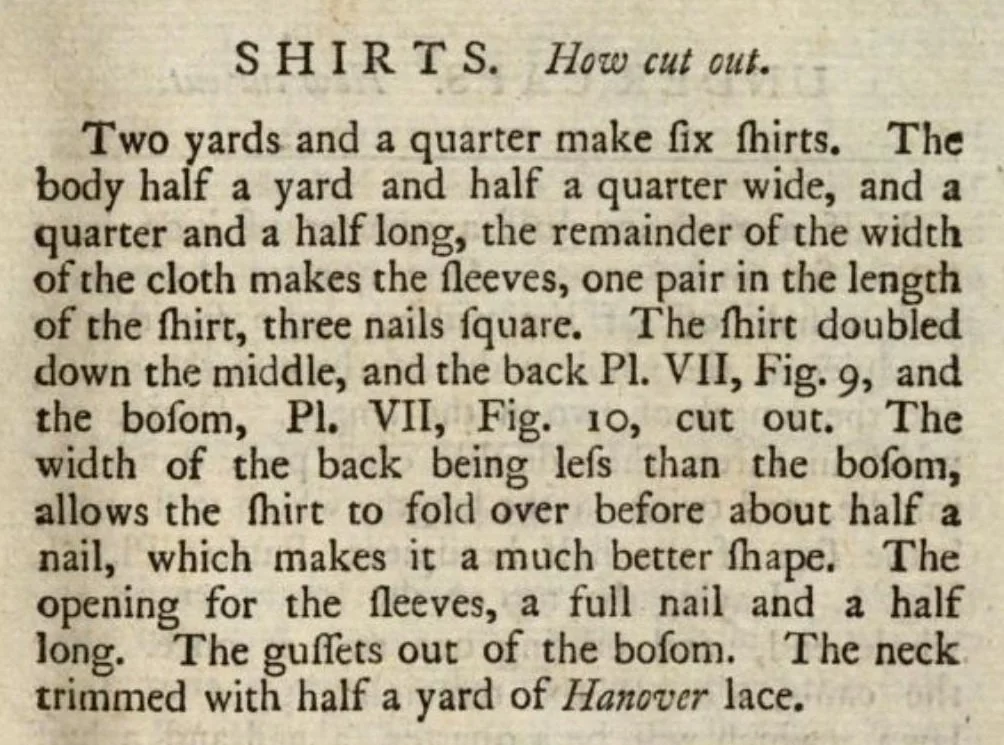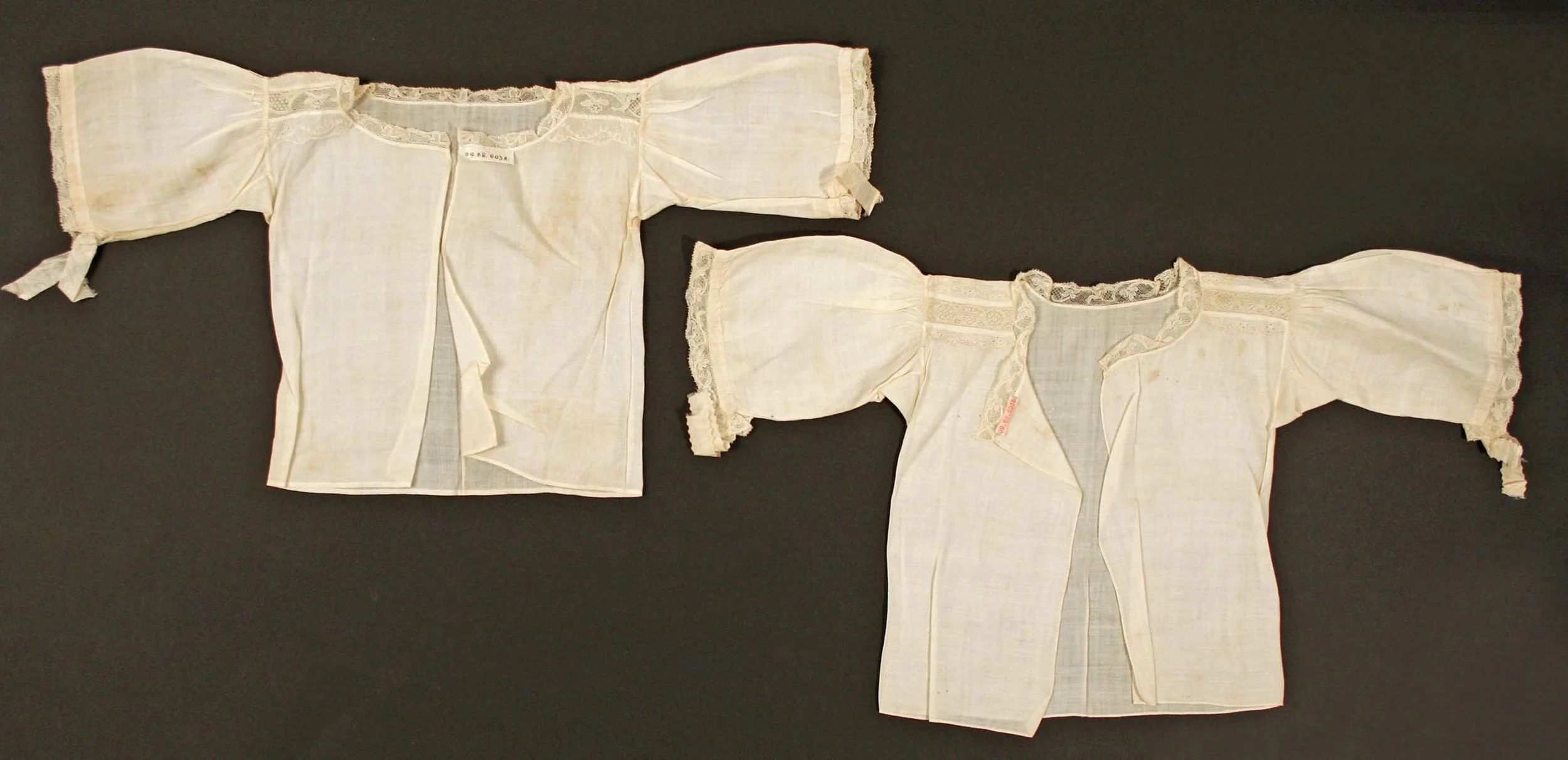18th Century Infants’ Shirts
Garsault provided instructions for making baby clothes in L’art du lingere (1771), including a “Chemiſe de Braſſiere” (fig. X) and a “Chemiſe du premier åge” (fig. XV).
Eric Krause notes that the chemise de brassière is for newborns up to six months, and afterwards replaced by the “shirt of the first age.”
Additional Resources
This site contains affiliate links for which I may be compensated
Baby Linen, or, How to Make a Basic Essential Layette for Eighteenth Century Re-enactor Infants
18th century infant’s shirt in Fitting & Proper
How to make shirts for child-bed linen, from Instructions for cutting out apparel for the poor (1789)
Centraal Museum 20956, a baby’s garment with a large collar and bobbin-lace trim, c. 1675-1750
MRAH, a quilted (?) shirt
Christie’s Lot 35 A / Sale 5945
Christie’s Lot 217 / Sale 5422, shirt with hollie point insertions
Several British babies' shirts at the Met, including 08.180.970, 09.68.603a, b, and 08.180.969
Bonhams Auction 12002, Lot 1, “An 18th Century linen baby's shirt, trimmed on the shoulder and round neckline with Flemish style baby lace.”
Colonial Williamsburg 1971-1570, infant's shirt with hollie point needlework and bobbin lace, England, 1700-1750
Rijksmuseum BK-1978-767, a baby’s shirt in linen batiste, c. 1725-1775
Colonial Williamsburg 2004-89, infant’s white linen shirt trimmed with linen bobbin lace, England, c. 1730-1760; “Infant’s shirt of white linen, trimmed at rounded neckline and edges of cuffs with linen bobbin lace. Shirt is cut in a T shape with full center-front opening. Underarm gussets. The straight sleeves are turned back in cuffs, with a chevron pattern ironed into the cuffs. The shirt is cut with no underarm seams in the body. Very narrow rolled hems at neckline, down center fronts, and at bottom.”
London Museum 53.38/5, c. 1738-1745; “White linen child's shirt with a round neck and short sleeves gathered at the shoulder. Back is open. Small crown stitched on the back in brown thread.”
PHM H7974, England, mid-18th century; “fine white linen with bobbin and needle made lace trim … Size: 9½" long.”
MFA 1978.428, linen shirt with linen bobbin lace and gold cuff links, Boston, c. 1764; “Child’s shirt of white linen with overlapping front opening, lace insert bands and openwork at shoulders. Pleated sleeves with triangular gussets at armpits. Mull neck and wristbands. Gold double button cuff links with incised blossoms.”
Newport Historical Society D100, c. 1775-1825; “White linen shirt, fine linen ruffles on sleeves, gussets, triangular shaped flaps on front and back of shirt.” (Undated example in the same collection: FIC.2014.71)
Colonial Williamsburg 1991-1180,1, linen trimmed with linen bobbin lace, probably Maine, 1760-1784
Wisconsin Historical Society 1983.200.4, Massachusetts, 1787; “Off-white very fine linen lawn; cut from one piece with straight sides and shoulder straps; only seams are at shoulders and where short, lightly gathered sleeves were set in; small triangular gussets under each sleeve; wide and deep scoop neckline; sleeve and neckline trim consists of a narrow band of white linen worked extensively in embroidery and drawn thread work; drawn thread work is also done around all the hems; back left open with no closures, slight overlap of back open edges.”
Met 2009.300.3287, probably British, late 18th century; “The pleating of the sleeves is labor-intensive and refined, as well as intricate, with almost miniscule needlework at the shoulders. The ruffle around the collar and the front edges is made from a finer, sheerer fabric than the rest, showing a sense of thoughtfulness.”
Concord Museum COS85.5, late 18th or early 19th century; “White linen baby's shirt featuring a square neckline and a collar flap in front and back. The short sleeves are trimmed at the bottom with lace. Unlike many other baby's shirts, this shirt is closed in both front and back.”
Infants’ knit shirts
Colonial Williamsburg 1985-139, a child’ shirt or waistcoat in knitted cotton, England, c. 1700-1750
Colonial Williamsburg 1998-31, infant’s knit undershirt, England, c. 1700-1750
Christie’s Lot 35 A / Sale 5945
Met 11.162.2, Germany
Whitworth T.1984.32, “Jacket knitted in the round from double white cotton yarn (Z-spun) and cut open at the centre front. Worked in stocking stitch with false seams at the sides (created by knitting a single stitch in purl). Patterned at the centre back, centre front openings and along the front and back of both sleeves with repeating hexagons. The lower edge and sleeve ends are bordered with an eight-pointed star pattern. The shoulders are patterned with opposing triangles. The gauge of the knitting is 8 stitches per 10mm and 12 rows per 10mm.”




